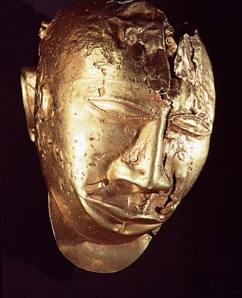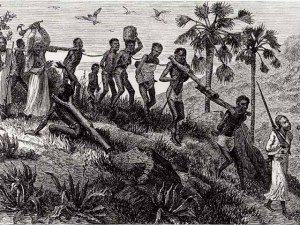Austin, Gareth (2009) “Coercion and markets: the political economy of slavery in West Africa, c.1450-1900”, paper presented for the Séminaire: Travail et conditions de vie en Afrique dans la longue durée, at the Paris School of Economics, 18/05/09.
Introduction
The use of slave labour in pre-colonial Western Africa has often been attributed to the small human densities in the region. But this argument is in contradiction with the fact that slavery was relatively uncommon in the area before the development of the Atlantic slave trade. Indeed, it is the European demand for African bond labour that created the mechanisms that were subsequently used by the “domestic” slave trade. Those two markets were complementary, in particularly, the Atlantic slave trade concentrated on men while the domestic demand was centred on women.
Inter-African slavery
Tellingly, the most significant growth in the numbers of slaves owned by Africans occurred at the end of the Atlantic trade. The fall of European demand led to a collapse of the average slave price. From 1804 to the early 1820s, costs plummeted by ±65%. Yet, prices started increasing once more after 1820, and kept on rise for most of the 19th century. The causes of this inflation of some 30% can very likely be attributed to the demand for slave coming from West Africa.
Slaves were commonly used for the production of goods destined to be exported to other villages or societies. It did not take much to buy a slave: the price of one slave equaled 1 or 2 months of work during the dry season (time of the year mostly devoted to the production of marketable products).
Even though waged labour existed marginally and thus cannot be considered alien to West African cultures, overall, no wage rate could be found at which demand for labour could match the labour supply. While, colonial administration could pay comparatively very high salaries; as late as 1906, local Ashanti wealth owners objected to the British officials adamant to end slavery in Ghana that unlike the European they were not able afford waged labour.
Slavery-based societies
In the last years before colonization, in the region that was about to be conquered by the French,as much as an estimated 30% of the population may have been enslaved. Such numbers required special social arrangements. Slaves were mostly foreigners and pagans in a Muslim society and as such aliens. Moreover they were commonly left kinless; however if a second generation was to arise (commonly from a free man and a slave woman), it was swiftly integrated into the mainstream society so as to avoid the emergeance of a new and potentially powerful cast. This non-reproduction of the slave population fueled a constant demand for new slaves.
One detail ought to be addressed: were they slaves or serves? It appears that except in a handful of cases (such as the large wheat-producing domains on the banks of the Niger river under the Songhai Empire), slaves were regarded as unfungigle assets but were not legally tied to the land.
Were slaves a sound investment?
Slaves commonly had one or two days “off” mostly dedicated to growing their own food or working for themselves, they were commonly allowed to own money and goods. This significantly diminished the surplus the masters could count on but it also decreased the cost of maintaining a larger number of slaves, besides it also integrated slaves into the system thus diminishing the risks of revolts. It took 3 to 5 years to cover the cost of a slave, hence it cannot be considered as a particularly sound investment since by that measure slave were 3 to 5 times less productive than free men. But there was no easily available replacement to slavery.
On a larger scale, slavery seem to have been a key factor in the replacement of the quasi-autarkic Western African household production system by a market economy after 1600. Slavery can be seen as a factor market (if a grossly inefficient one) that channeled labour to the most productive areas. As such it is no surprise that – as it was the case at the same time in the New World – slavery was a growth-inducing factor. Although the negative externalities of the system were significant (warfare, destruction of trade and markets), it enabled West Africa to experience a growth rate that may have equalled that of Europe at the same time.
Conclusion
The spread of capital assets, namely a pair of very lucrative cash crops (mostly cocoa) allowed the rise of a local free (male) labour market, revealed clearly by the flow of migrants to the cocoa-producing regions. The decline of female bond labour on the other hand happened slower.


